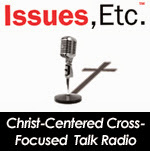The chief purpose of the special vestments worn by the pastor is to exalt, not the man, but the office of the holy ministry given to the Church by Christ. In fact, the vestments are intended to hide the man wearing them so that the focus is on his office, through which the Holy Spirit works to build up the people of Christ. Vestments, in and of themselves, are adiaphora—things neither commanded nor forbidden by God. As Lutherans, we use them gladly, both as a means to honor the God-given ministry of the Word, and as a confession of our place in the Church catholic. As we confess in the Book of Concord:
“It is helpful, so far as can be done, to honor the ministry of the Word with every kind of praise against fanatical people. These fanatics imagine that the Holy Spirit is given not through the Word, but through certain preparations of their own” (Ap. XIII:13).
“At the outset we must again make the preliminary statement that we do not abolish the Mass, but religiously maintain and defend it. For among us masses are celebrated every Lord’s Day and on the other festivals, in which the Sacrament is offered to those who wish to use it, after they have been examined and absolved. And the usual public ceremonies are observed, the series of lessons, of prayers, vestments, and other like things” (AC:XXIV:1).
Here is a brief list of the most common vestments still used by Lutherans:
Basic pastoral vestments:
Cassock A long, close-fitting black robe that used to be the everyday wear of the clergy. It has been largely replaced by the clergy shirt and collar, but may still be worn by clergy as they perform any ministerial duties.
Surplice A white tunic worn over the cassock in the Divine Service or Daily Offices. It is worn by a pastor who is not the celebrant at the Sacrament. It may also be worn by choir members or altar servers.
Alb A long, close-fitting white robe worn by ministers at the Divine Service. It symbolizes the baptismal garment and the righteousness of Christ.
Stole A long, narrow strip of cloth draped around the neck, symbolizing ordination. It is worn only by clergy. Its color changes with the liturgical season.
Cincture A rope that is tied around the waist, serving as a belt to hold the alb and stole in place underneath the chasuble.
Chasuble A poncho-like garment worn over the alb and stole, worn only by clergy, used exclusively by the celebrant at the Eucharist. Its color changes with the liturgical season.
Additional vestments for a bishop:
Cope A long, circular cape.
Mitre A pointed, ceremonial hat used by bishops to signify their office.
Crozier A long staff with a crook at the top, resembling a shepherd’s staff.
_______________________________________________
Divine Service Explanation #1 - The Purpose of the Divine Service
Divine Service Explanation #2 - The Church Year and Lectionary







